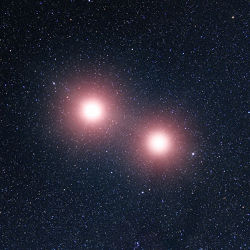Super-resolution for astronomical applications

Due to the diffraction of light, an image of a point will never be a perfect point, but rather a widened dot. For this reason, every imaging system has a resolution limit, which is defined as the smallest separation that the object points can have, in order to still be distinguishable in the recorded image [1]. In the case of a conventional telescope system, the resolution limit is determined by the size of the primary mirror and to achieve better resolutions, ever larger telescopes have therefore been designed, making them extremely expensive and technologically challenging to build.
Using advanced strategies, it is possible to go beyond these limitations of conventional systems, which is called super-resolution. One way of enhancing resolution of an image is by the means of image processing [2]. It usually involves applying prior knowledge about the object and the imaging process, or fusing information from several lower-resolution images, in order to produce a single higher-resolution image. In this project, however, we are exploring possibilities to extract more information about the object through the measurement process itself.
Such system-based super-resolution has already been demonstrated in microscopy, for which the Nobel Prize in Chemistry was awarded in 2014 [3]. These techniques, however, involve careful manipulation of illumination and the sample – something that is not possible in astronomy. An alternative approach therefore needs to be found to enable super-resolution for astronomical applications.
The resolution problem has been revisited and studied from the perspective of quantum estimation theory in a number of recent publications [4-8]. One of the central quantities in this theory is the so called Fisher information [9]. It is the information about a parameter that is gained by performing a certain measurement on a physical system. If the Fisher information is maximized over all the possible measurements, one then speaks of quantum Fisher information, which gives the quantum bound on the attainable information about the corresponding parameter. Fisher information is also closely related to the measurement error – inverting the Fisher information leads to the Cramer-Rao bound, which defines the lower limit on the variance of an estimator for the chosen parameter.
Quite surprisingly, the quantum Fisher information for separation between two equally bright and symmetrically positioned point sources is constant at all separations, whereas the Fisher information in the case of conventional imaging vanishes when the separation goes to zero [5]. Conventional imaging is thus suboptimal for estimating the separation and the measurement that saturates the quantum Fisher information has already been identified. Moreover, measurements that outperform conventional imaging have also been experimentally demonstrated [10,11].
In practice, however, the sources (e.g. stars or exoplanets) are never equally bright and due to the lack of knowledge about their geometrical centroid, it would be impossible to have them symmetrically positioned about the optical axis. We therefore need to consider simultaneous estimation of separation, brightness, and centroid of the two sources, meaning that the more complex multi-parameter quantum estimation theory needs to be applied [12,13].
Initial study objectives
The main objective of this study is to develop and experimentally verify a realistic super-resolution approach, where no prior knowledge about the brightness nor the centroid of the two point sources would be required.
This will be achieved in several steps. First, the theoretical bounds on simultaneous estimation of separation, brightness and centroid of the two sources need to be determined by calculating the corresponding quantum Fisher information matrix. Ideally, a measurement scheme that would saturate all these bounds simultaneously would be identified next. Since the existence of such measurement is not guaranteed, the trade-offs between estimation precision of the three parameters will need to be considered and a practically realizable measurement scheme that would still outperform conventional imaging will be chosen. Finally, the chosen measurement scheme will be experimentally tested and evaluated.
References
- Lord Rayleigh, “Investigations in optics, with special reference to the spectroscope,” Phil. Mag. 8, 261 (1879).
- S. C. Park, M. K. Park, M. G. Kang, "Super-Resolution Image Reconstruction: A Technical Overview", IEEE Signal Process. Mag. 20, 21 (2003).
- https://www.nobelprize.org/nobel_prizes/chemistry/laureates/2014/press.html
- L. Motka, B. Stoklasa, M. D’Angelo, P. Facchi, A. Garuccio,Z. Hradil, S. Pascazio, F. V. Pepe, Y. S. Teo, J. Řeháček, and L. L. Sánchez-Soto, “Optical resolution from Fisher information”, Eur. Phys. J. Plus 131, 130 (2016).
- M. Tsang, R. Nair, and X.-M. Lu, “Quantum Theory of Superresolution for Two Incoherent Optical Point Sources”, Phys. Rev. X 6, 31033 (2016).
- R. Nair and M. Tsang, “Far-Field Superresolution of Thermal Electromagnetic Sources at the Quantum Limit”, Phys. Rev. Lett. 117, 190801 (2016).
- C. Lupo and S. Pirandola, “Ultimate Precision Bound of Quantum and Subwavelength Imaging”, Phys. Rev. Lett. 117, 190802 (2016).
- J. Rehacek, M. Paúr, B. Stoklasa, Z. Hradil, and L. L. Sánchez-Soto, “Optimal measurements for resolution beyond the Rayleigh limit”, Opt. Lett. 42, 231 (2017).
- M. G. A. Paris, “Quantum Estimation for Quantum Technology”, Int. J. Quantum. Inform. 07, 125 (2009).
- M. Paúr, B. Stoklasa, Z. Hradil, L. L. Sánchez-Soto, and J. Rehacek, “Achieving the ultimate optical resolution”, Optica 3, 1144 (2016).
- W. K. Tham, H. Ferretti, and A. M. Steinberg, “Beating Rayleigh’s Curse by Imaging Using Phase Information”, Phys. Rev. Lett. 118, 070801 (2017).
- M. Szczykulska, T. Baumgratz, and A. Datta, “Multi-parameter quantum metrology”, Adv. Phys. X 1, 621 (2016).
- S. Ragy, M. Jarzyna, and R. Demkowicz-Dobrzański, “Compatibility in multiparameter quantum metrology”, Phys. Rev. A 94, 052108 (2016).